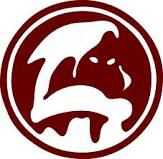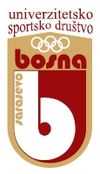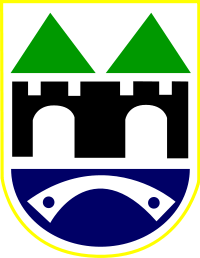Horde Zla
| Horde Zla Udruženje navijača FK Sarajevo (UNFKS) | |
|---|---|
 Horde Zla - Hordes of Evil | |
| Nickname | Hordaši |
| Abbreviation | HZ'87 |
| Founded | 1987 |
| Type | Supporters' group, Ultras group |
| Team | FK Sarajevo |
| Motto |
"Do zadnjeg dana život mog samo Saraj'vo" "to the very last day of my life, only Sarajevo!" |
| Headquarters | Sarajevo, Bosnia and Herzegovina |
| Arenas | |
| Stand | North |
| Colors | |
| Website | hordezla.ba |
Horde Zla (Hordes of Evil) are an Ultras group who support the Bosnian football club FK Sarajevo.[1]
History
FK Sarajevo supporters were historically called Pitari while an individual was, and is still, known as a Pitar. The nickname, meaning a consumer of the local Bosnian dish pita, was originally a derogatory label given by fans of working class FK Željezničar that implied the upper-class background of most FK Sarajevo supporters.[1]
By the early to mid 1980's, the rowdiness of the Pitari during matches of the time provoked large media coverage and accusations of being dangerous. During a big season game in April 1986 a maroon painted snake, mostly probably a specimen of the venomous Vipera ammodytes, was thrown off the East stand onto the visitors bench. Alarmed by this, the club management headed by then Director Svetozar Vujović opened the North stand of the Asim Ferhatović Hase Stadium to the most fanatical of fans.[2]
Soon after, the name Horde Zla, that directly translates to Hordes of Evil, was born. Namely, several prominent members of the Pitari, influenced by the growing Ultras subculture in Europe decided to create a new identity based on a popular Zagor comic book of the same name. Today, Pitari and Horde Zla are interchangeable. By the end of 1987 Horde Zla became one of the fastest growing youth organisations in the city of Sarajevo.[1]
During the late 1980s and early 1990s Horde Zla became infamous for a few of the largest fan riots in Yugoslavia, including the 1991 stabbing of two FK Partizan supporters in front of the JNA Stadium in Belgrade and the 1988 riots in the city of Mostar before a league game between FK Sarajevo and Velež Mostar, resulting in the stabbing of a local resident and the destruction of large amounts of public and private property. Unlike most other Ultra firms in Yugoslavia that had popularized and marketed the growing nationalist fervor that would later lead to the Yugoslav Wars, Horde Zla considered themselves Bosniaks and the other firms nationalist orientation was often a trigger for violence.[3]
When the Bosnian War began, most members of Horde Zla joined the newly formed Army of the Republic of Bosnia and Herzegovina in an effort to defend their city and newly independent state, and many did not survive. Today a plaque exists, to honor the members of Horde Zla that had laid down their lives defending their city and country.
After the war Horde Zla took back their place on the North stand of the Asim Ferhatović Hase Stadium on the 10th anniversary of the firm's founding. The Horde Zla again were on the front pages when, during the 1998 Sarajevo derby against FK Željezničar, they invaded the pitch after some members of the opposing firm, The Maniacs assaulted the FK Sarajevo goalkeeper Mirsad Dedić, resulting in a large on-pitch battle that concluded with over thirty serious injuries.
Horde Zla again made headlines in October 2009, during the infamous Široki Brijeg Football Riots. The riots resulted in the death of Vedran Puljić, a member of Horde zla and over thirty serious injuries, including four gunshot wounds.[4] In April 2010 Horde zla invaded the pitch after Sarajevo played a 1:1 draw against NK Široki Brijeg, and eventually went on to demolish large portions of the stadium including the VIP box and the benches in clashes with the police and security personnel. The incident resulted in over 40 minor and serious injuries.[5] In July 2012, Horde Zla clashed with Levski Sofia supporters in the first leg of a UEFA Europa League match that was held in Sofia, Bulgaria.[6] On 20 July 2013 Horde zla clashed with the fans of Albanian club FK Kukësi in Tirana before the start of a Europa League match.[7] On 25 September 2013 Horde zla invaded the pitch during a game versus FK Borac, charging on the visiting fans situated on the South stand of the Asim H. Ferhatović stadium. The police were forced to intervene and the fixture was subsequently abandoned.[8]
Horde zla garner very close relations with the supporters of Dynamo Dresden.[9][10]
USD Bosna

Horde zla and FK Sarajevo garner a close relationship with USD Bosna, or University Sport Society Bosna (Bosnian: Univerzitetsko sportsko društvo Bosna). The most notable members of said society are KK Bosna Royal, that won the Euroleague Basketball title in 1979[11] and RK Bosna Sarajevo, that reached the 1/8 finals of the EHF Champions League in 2011.[12]
The relationship traditionally stems from the fact that both sides share unique maroon and white club colours, which lead KK Bosna Royal to garner most of its fan base from FK Sarajevo in its rise to the top in the mid and late 1970s. Through time the two sides became colloquially interchangeable, as Horde zla equally followed both, forming a so-called Maroon Family. Even though RK Bosna did not represent a big player in Yugoslav handball, the club's post-war ascent was thoroughly supported by Horde zla.
Notable supporters
- Famous, non-football related, supporters of FK Sarajevo are listed on this list alphabetically.
- Enis Bešlagić[13] – Bosnian actor and television personality
- Halid Bešlić – Prominent Bosnian folk and sevdah musician
- Emerik Blum[14] – Bosnian Jewish businessman, philanthropist and founder and first director of one of Eastern Europe's largest conglomerates, Energoinvest
- Jovan Divjak – Retired military general
- Aleksandar Hemon[15] – World renowned Bosnian-American novelist, essayist and literary critic
- Safet Isović – One of the most prominent and popular performers of Bosnian traditional music sevdalinka
- Alija Izetbegović – The first President of Bosnia and Herzegovina
- Sanela Diana Jenkins – Bosnian entrepreneur and philanthropist
- Zlatko Lagumdžija – Politician and former Bosnian Minister of Foreign Affairs
- Nenad Marković[16] – Retired professional basketball player
- Dino Merlin[17] – Prominent Bosnian singer-songwriter and producer
- Kemal Monteno[18] – Popular Bosnian singer-songwriter
- Danis Tanović – Academy Award winning film director
- Ismet Bajramović "Ćelo" – Bosnian soldier, organized crime figure and leader of supporters FK Sarajevo.
References
- ↑ 1.0 1.1 1.2 "O nama" (in Bosnian). Hordezla.ba. Retrieved 2014-03-17.
- ↑ "Navijači" (in Bosnian). Fcsarajevo.ba. Retrieved 2014-03-17.
- ↑ "Horde zla su uvijek bile protiv nacionalizma" (in Bosnian). Fksinfo.com. Retrieved 2014-03-17.
- ↑ "The Curse of Hooliganism". eupm.org. Retrieved 2014-08-12.
- ↑ "Horde zla se sukobile sa navijačima Levskog" [Horde zla clashed with Levski fans] (in Bosnian). Otisak.ba. Retrieved 2014-03-17.
- ↑ "Horde zla prekinule utakmicu u Sarajevu" (in Bosnian). Nezavisne novine. Retrieved 2014-03-17.
- ↑ "KK Bosna je prije 34 godine bio najbolji evropski klub". Klix.ba. Retrieved 2014-08-12.
- ↑ "Velux EHF Men’s Champions League – Last 16 Fixtures". ehfcl.com. 2011-03-07. Retrieved 2011-03-08.
- ↑ "Urnebesni komentari, šale i smijeh do suza na stadionu Koševo" (in Bosnian). Source.ba. Retrieved 2014-03-17.
- ↑ "Emerik Blum: Financial Times ga je opisao kao "oličenje socijalističke poslovnosti"" (in Bosnian). Slobodna Bosna. Retrieved 2014-03-17.
- ↑ "Ekskluzivni intervju: Aleksandar Hemon" (in Bosnian). Radiosarajevo.ba. Retrieved 2014-03-17.
- ↑ "Bosna se treba ugledati na Partizan, to je jedino rješenje" (in Bosnian). Klix.ba. Retrieved 2014-03-17.
- ↑ "Dino Merlin WikiQuotes" (in Bosnian). WikiQuotes. Retrieved 2014-03-17.
- ↑ "Kemal Monteno: Majka mi je prala dresove za FK Sarajevo" (in Serbian). Blic.rs. Retrieved 2014-03-17.
External links
| Wikimedia Commons has media related to FK Sarajevo. |
| ||||||||||||||||||||||||||||||||||||||
